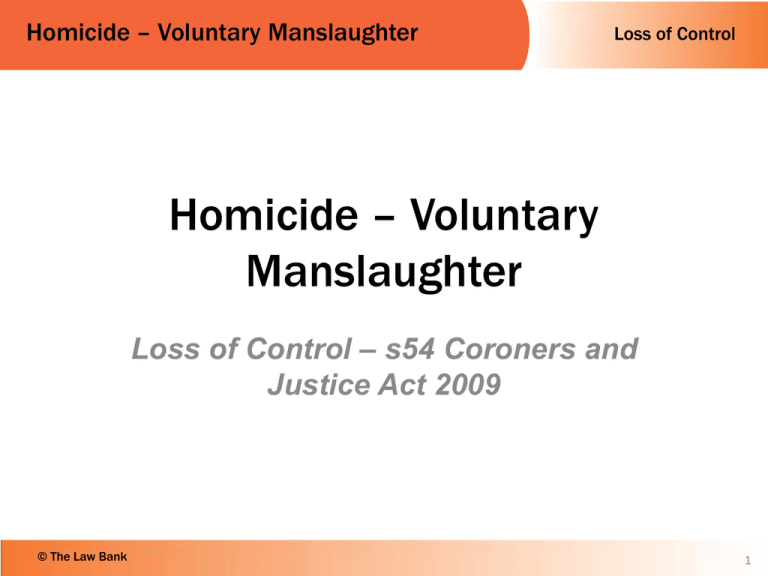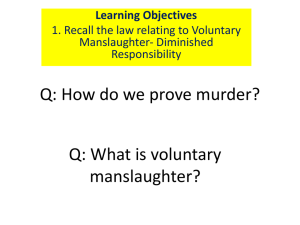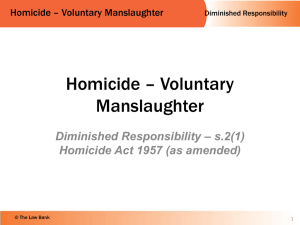
Homicide – Voluntary Manslaughter
Loss of Control
Homicide – Voluntary
Manslaughter
Loss of Control – s54 Coroners and
Justice Act 2009
© The Law Bank
1
Homicide – Voluntary Manslaughter
Loss of Control
Issues with the old law (C issue)
• Sudden and temporary loss of control
• Role of the jury
• Meaning of the reasonable man
• Range of behaviour that could be provoking
© The Law Bank
2
Homicide – Voluntary Manslaughter
Loss of Control
New Law
• Provocation existed at common law before the
law in this area was modified bys.3 Homicide Act
1957 (now ceases to have effect – s56 (2a) CJA
2009)
• This area has now been replaced by s54 and
55 of the Coroners & Justice Act 2009.
© The Law Bank
3
Homicide – Voluntary Manslaughter
Loss of Control
The New Law
• Before you continue –
Print, then read and précis ‘Loss of Control’
by Carol Withey:
http://www.criminallawandjustice.co.uk/index.p
hp?/Analysis/loss-of-control.html
‘Loss of Control’ is now under s54 of the
Criminal Justice Act 2009.
© The Law Bank
4
Homicide – Voluntary Manslaughter
Loss of Control
New Partial Defence - Loss of Control - s54(1) …
(a) D’s act in killing resulted from loss of self-control –
i.e. Did D lose control? (old law required sudden loss
of control – watch Ahluwalia film to see how under the
old law d would fall at the first hurdle!
(b) loss of control had a qualifying trigger
(c) A person of D’s sex and age, with a normal degree
of tolerance and self-restraint, in the circumstances of
D, would have reacted in the same/similar way.
• Use each of the above as one third of your para 5!
© The Law Bank
5
Homicide – Voluntary Manslaughter
Loss of Control
Evidence of Loss of Control
• The judge must decide if there is enough
evidence and the Jury must assume that the
defence is satisfied unless the Crown proves
beyond all reasonable doubt otherwise. (note
impact of R vDoughty – crying baby)
• No longer a requirement that loss was sudden
© The Law Bank
6
Homicide – Voluntary Manslaughter
Loss of Control
Role of the judge in loss of control pleas
• Look at these previous cases…
– Do you think they would meet the new threshold?
– Should the provocation have gone to the jury?
R v Doughty
© The Law Bank
R v Betambeau
R v Baillie
R v Pearson
7
Homicide – Voluntary Manslaughter
Loss of Control
Loss of Self Control
(2) For the purposes of subsection (1)(a) it does not matter
whether or not the loss of control was sudden:
Issues with this section:
• The longer the gap the more likely
the judge will withdraw it
R v Duffy 1949
‘Sudden and temporary loss of control’
•Allows for a ‘cooling off period’
per Ahluwalia.
•Law Commission did not want to
keep these words
R v Cocker 1989
‘Still must be a loss of control’
•Allows a whole category of
provoking actions or words to be
taken into account.
© The Law Bank
8
Homicide – Voluntary Manslaughter
Loss of Control
Loss of Self Control
Subsection (1) does not apply if, in doing or being a party to
the killing, D acted in a considered desire for revenge.
1. Why might these words cause problems?
2. How might this have affected these older cases?
R v Mohammed
© The Law Bank
R v Ibrams & Gregory
R v Baillie
9
Homicide – Voluntary Manslaughter
Loss of Control
Qualifying trigger
• NOTE – Revenge (where have we seen this before?)
does not apply (s54.4) and neither does sexual infidelity
(Mohammed) (s55.6b)
• 2 accepted QT’s:
• 1. Fear of serious violence from V against D
• 2. Thing or things ‘done or said’ (or both) – restricted to
– (a) Of an extremely grave character
– (b) Caused D to have a justifiable sense of being
seriously wronged.
© The Law Bank
10
Homicide – Voluntary Manslaughter
Loss of Control
Applicability of case law
• Old cases (pre 2009) no longer binding law – but
they are useful for comparison purposes…
– Doughty (1986) – crying baby
– Davies (1975) – D provoked by wife’s lover into
shooting his wife
– Pearson (1992) – D provoked by father’s abusive
treatment of D’s brother into killing father with
sledgehammer
© The Law Bank
11
Homicide – Voluntary Manslaughter
Loss of Control
Self induced actions
• To stop the possibility of a later appeal, D should
usually be given the benefit of the doubt
• This may include cases where D himself has
started the trouble:
– Johnson (1989) – But not if done so as to provide an
excuse to use violence s55(6a)
© The Law Bank
12
Homicide – Voluntary Manslaughter
Loss of Control
Loss of self-control
• Revenge – why is the notion of revenge
inconsistent with the defence of provocation/loss
of control?
• Note s54(4) – requires that the defendant did not
act in a ‘considered desire for revenge’
© The Law Bank
13
Homicide – Voluntary Manslaughter
Loss of Control
Cooling off period
• D had/may still have difficulty in successfully
pleading provocation if they have waited some
time before acting.
– Duffy (1949)
– Thornton (1992)
– Ahluwalia (1992)
• Do these cases still apply in the light of reform?
© The Law Bank
14
Homicide – Voluntary Manslaughter
Loss of Control
Cooling off period
• Despite apparent unfairness, the courts in
domestic violence cases had consistently upheld
the Duffy test which required a ‘sudden and
temporary loss of self-control’.
• Sudden has now been removed. Would the case
of Baillie (1995) be applicable?
© The Law Bank
15
Homicide – Voluntary Manslaughter
Loss of Control
Qualifying trigger s.55
Who can be
threatened?
What about
other types of
abuse?
Who can issue
the provocation?
First Trigger
D’s loss of self-control was
attributable to D’s fear of
serious violence from V against
D or another identified person
Serious violence
© The Law Bank
Judged subjectively
So D can even plead where:
•Uses excessive force
•Makes a mistake
16
Homicide – Voluntary Manslaughter
Loss of Control
Qualifying trigger s.55
Extremely grave character
Second Trigger
This subsection applies if D’s
loss of self-control was
attributable to a thing or things
done or said (or both) which –
(a) Constituted circumstances
of an extremely grave
character, AND
(b) Caused D to have a a
justifiable sense of being
seriously wronged.
Justifiable sense of being seriously wronged
© The Law Bank
17
Homicide – Voluntary Manslaughter
Loss of Control
Other limitations on the qualifying trigger
If D incites the violence from V, as
an excuse, he cannot use it.
R v Johnson 1989
Sexually infidelity isn’t accepted
as an excuse
Could D use
loss of
control as a
defence in
these
situations?
D picks up the phone to hear his
wife conducting a phone sex
conversation with her lover. He
put down the phone and
strangles her.
D and V are arguing. V has been
abusive to to V and punches
her. He also says that she is
useless and that he has been
having an affair with her sister
for the last year. D stabs him
killing him.
D comes home to find her
husband sexually abusing their
young child. She stabs him to
death.
Are there any other situations which should have been included?
© The Law Bank
18
Homicide – Voluntary Manslaughter
Loss of Control
Objective test – standard of self-control
• S54(1)(c) – would a person of D’s sex and age
have acted in a similar way?
The jury must be satisfied that a “person of D’s sex
and age, with a normal degree of tolerance and
self-restraint, and in the circumstances of D, would
have reacted in the same/similar way.” AG v Holley
© The Law Bank
19
Homicide – Voluntary Manslaughter
Loss of Control
The objective test
Were the actions of V enough to
prompt a person of D’s sex and
age with a normal degree of
tolerance and self restraint to
lose their self control?
AND
Was it enough that D in those
circumstances lost their control?
• Why include age?
• What about gender?
© The Law Bank
20
Homicide – Voluntary Manslaughter
Loss of Control
How is this different to earlier tests?
Case law progression
Stage one:
Can you match the case –
to the legal principle– to
the description?
Stage two:
Can you put them in order
and state how the test
has developed?
© The Law Bank
Its not!
21
Homicide – Voluntary Manslaughter
Loss of Control
Answers!
Bedder v DPP
1954
‘Ha ha, What are you
going to do with that?
Oh my is that a knife in
your pocket or are you
just pleased to see
No characteristics are
relevant to D’s selfcontrol
me?’
DPP v Camplin
1978
A good pan will get you
out of most problems
Age and sex are the
only relevant
characteristics relevant
for self-control
“I don’t care how much
money you give me I
am still a better lover
than your new bloke!”
Mental characteristics
should not be taken
into account when
assessing the
reasonable man
Luc Thiet Thuan
1979
© The Law Bank
22
Homicide – Voluntary Manslaughter
Loss of Control
Answers!
R v (Smith) Morgan
I am a real tool for
reacting like that. Hic.
Sob.
2000
AG Jersey v Holley
2005
Any characteristics
which affects D’s selfcontrol may be
included
‘I know we are no
longer together but
you cannot expect me
to like your new lover especially when I am so
drunk and armed with
an axe!’
Age and sex are the
only relevant
characteristics relevant
for self-control
How many women can
have affairs in one
appeal hearing?
Age and sex are the
only relevant
characteristics relevant
for self-control
R v James & Karimi
2006
© The Law Bank
23
Homicide – Voluntary Manslaughter
Loss of Control
Higher order thinking
1.
2.
The old law is still good law
Read the case report for Camplin and answer the following
questions:
1.
2.
3.
4.
5.
6.
7.
What were the facts of the case?
What was the provocations alleged?
What characteristics did D want to include in the reasonable man test?
What does Diplock say the RM should include?
What issue of public policy limited the defence?
What are your thoughts about this?
Should these be temporary or permanent characteristics?
Extension – can you extend your commentary by referring to at least one other
controversial case?
© The Law Bank
24
Homicide – Voluntary Manslaughter
Loss of Control
Objective test – standard of self-control
• The new test is similar to DPP v Camplin (1978)
• Privy Council in A-G for Jersey v Holley [2005]
• Essentially the age and sex of D can be
attributed.
© The Law Bank
25
Homicide – Voluntary Manslaughter
Loss of Control
The objective test
Were the actions of V enough to
prompt a person of D’s sex and
age with a normal degree of
tolerance and self restraint to
lose their self control?
• Why include age?
• What about gender?
© The Law Bank
AND
Was it enough that D in those
circumstances lost their control?
• What word has
changed from the old
law?
Circumstances …was
characteristics.
• Why might that be
more flexible than the
old approach?
26
Homicide – Voluntary Manslaughter
Loss of Control
Which characteristics?
• Is this the same as circumstances in s.54?
• In a more liberal approach, the courts have
allowed mental characteristics to be attributed to
the reasonable man:
– Ahluwalia (1992)
– Dryden (1995)
– Humphreys (1995)
© The Law Bank
27
Homicide – Voluntary Manslaughter
Loss of Control
Temporary and self-induced characteristics
• Generally, a transient state of mind, e.g.
intoxication will not amount to a ‘characteristic’.
However, the H of L has indicated that the jury
should look at the ‘entire factual situation’ when
considering the gravity of the provocation:
– Morhall 1996.
• See also the cases of:
– Gregson (2006)
– Hill (2008)
© The Law Bank
28
Homicide – Voluntary Manslaughter
Loss of Control
Apply the law
• Answer the
question that is on
your desk using the
knowledge you now
have.
• Remember IDEA
• Use this sequence
for the E and A
parts:
© The Law Bank
Murder: Actus Reus
Murder: Mens Rea
Loss of control
Qualifying trigger?
Enough to provoke the person
with the age and sex of D in
the circumstances
Causation?
29
Homicide – Voluntary Manslaughter
Loss of Control
Objectives
• Define the elements of the partial defence of
Loss of Control
• Explain in what circumstances the partial
defence of Loss of Control can be used by a
defendant
• Describe the application of the partial defence
by reference to case law and problem scenarios
© The Law Bank
30












